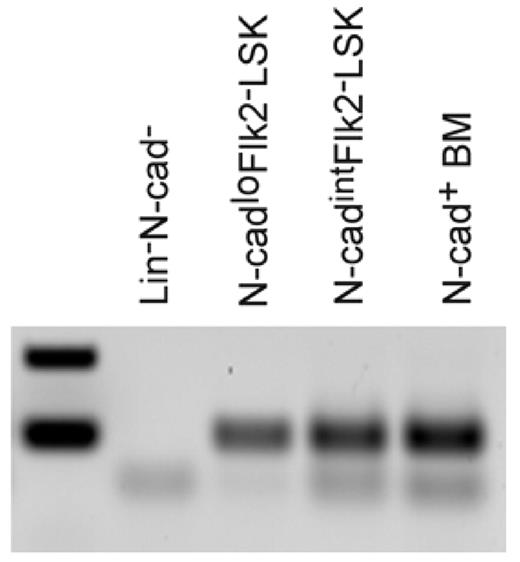Abstract
Within the bone marrow, three hematopoietic stem cell niches have been identified; the osteoblastic niche (Arai et al., 2004; Calvi et al., 2003; Nilsson et al., 2001; Zhang et al., 2003), the vascular niche (Kiel et al., 2005), and the CAR cell niche (Sugiyama et al., 2006). The adhesion molecule N-cadherin has been found associated with the osteoblastic and CAR cell niches, implicating N-cadherin’s function for hematopoietic stem cell (HSC) anchoring and signaling (Arai et al., 2004; Muguruma et al., 2006; Zhang et al., 2003). However, as of yet, a HSC population expressing N-cadherin has not been fully characterized. Therefore, we examined how N-cadherin expression in HSCs relates to their function and lifecycle. Unexpectedly, we found that doses of 5000 bone marrow cells expressing the highest level of N-cadherin (N-cadherinhi) failed to reconstitute hematopoietic lineages in irradiated recipient mice. An explanation for this engraftment failure came with detailed cell surface phenotyping which revealed that these N-cadherinhi cells were primarily Lineage+ and devoid of the characteristic hematopoietic stem pool, Lineage-Sca+cKit+ (LSK) cells. Instead, we found that Flk2-LSK HSCs express a gradient of N-cadherin which could be described as low (N-cadherinlo) to intermediate (N-cadherinint) levels (Figure1).
FACS applications were used to isolate pure populations of these N-cadherinlo and N-cadherinint Flk2-LSK HSCs. Real time RT-PCR (N-cadherin primers crossed the intron between Exon 2 and 3).
(Figure 2), microarray studies, and competitive reconstitution transplantation assays revealed that this N-cadherin division of Flk2- LSK HSCs formed two populations with very distinct properties. In transplantation assays the N-cadherinlo population more robustly reconstituted the hematopoietic system. Principle Component Analysis and gene ontology analysis of microarray data revealed that the N-cadherinlo cells expressed genes that may prime them to respond to signals and to mobilize. This data was confirmed with mobilization studies which showed that HSCs mobilized from bone marrow to spleen were predominantly N-cadherinlo. In contrast, the expression profile of N-cadherinint cells suggests they are more ‘reserved’ and this population was also maintained with HSCs spared by 5-fluouracil (5FU) treatment. Our results suggest that differential N-cadherin expression reflects important functional distinctions between HSC subpopulations. N-cadherinlo HSCs, with their robust reconstitution efficiency and properties similar to mobilized HSCs, may have clinical relevance.
Author notes
Disclosure: No relevant conflicts of interest to declare.



This feature is available to Subscribers Only
Sign In or Create an Account Close Modal